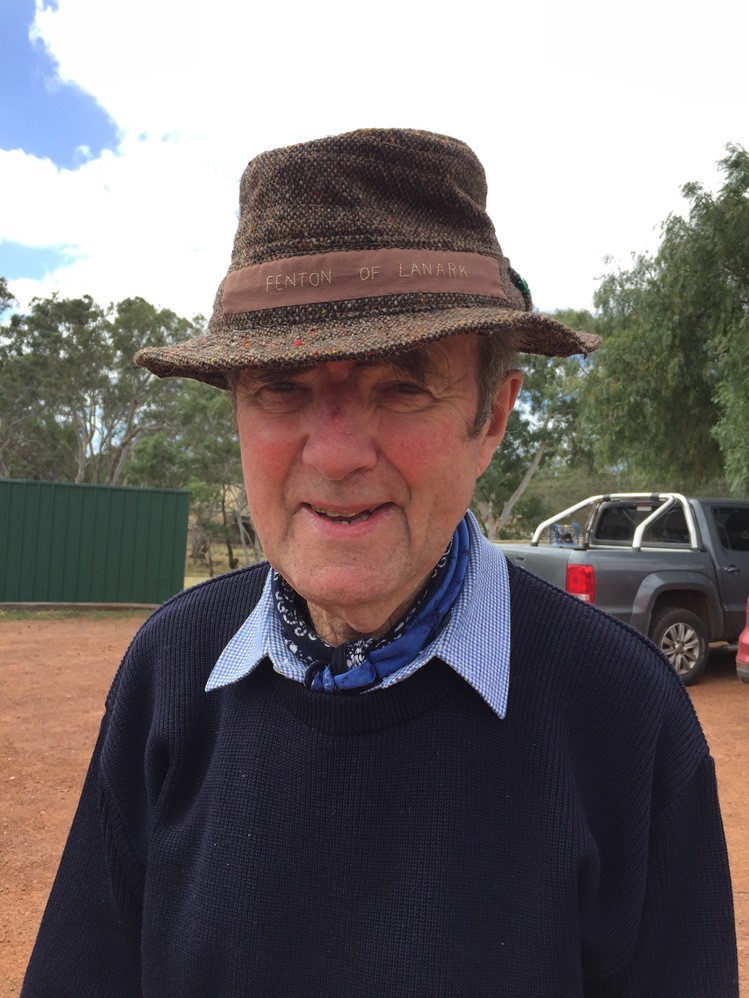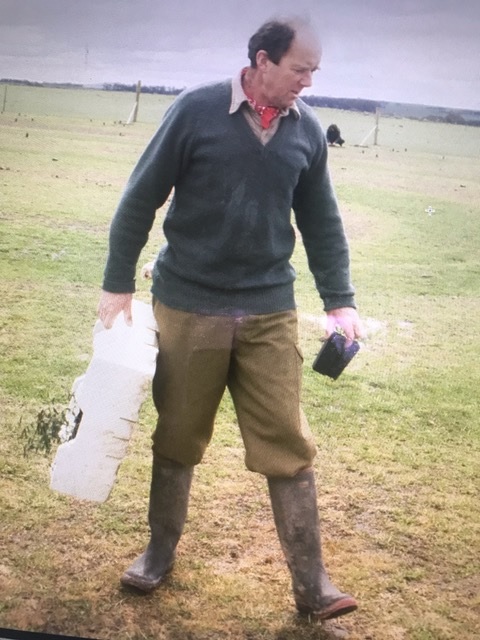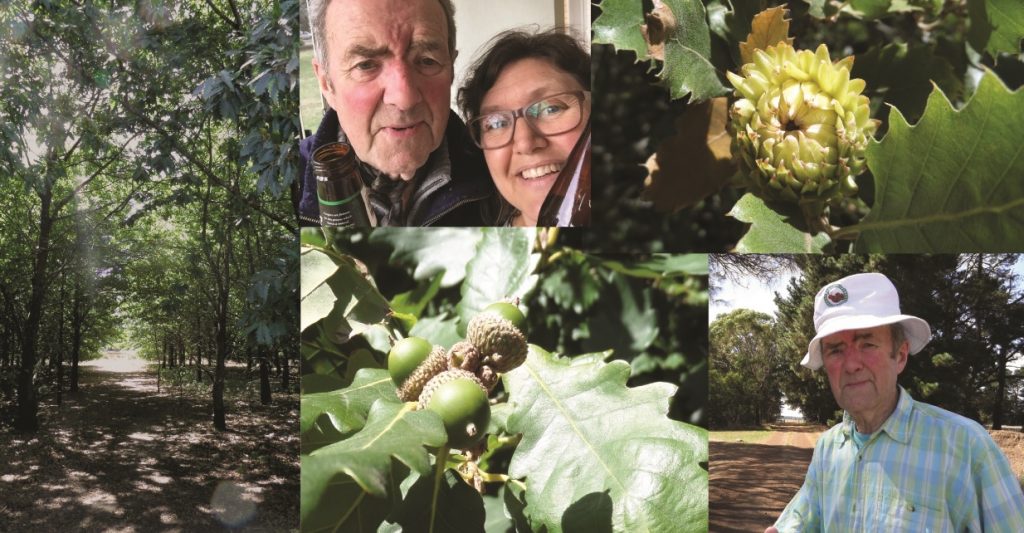Vale John Fenton – honouring the life and impact of a true visionary who was ahead of his time
Vale Mr. Fenton – by Mark Bachmann
Every now and then you meet someone who makes a deep and lasting impression on you. In my own personal journey towards becoming especially passionate about wetland restoration, there are a handful of people in particular who have motivated and inspired me along the way.
Given that we didn’t cross paths very often over the last 20 years, John Fenton may have been surprised to learn that he was one such person to me. I will never forget the first time I heard him speak at a conference in Adelaide, maybe 20 years ago, and it was just so refreshing! He spoke his mind, told it like it was and was a man of both conviction and action. The audience took in every word, because he was compelling. I chased him down afterwards, we spoke for a short while, and he gave me a brochure about some of the results of his work produced by Birdlife Australia in 1999 (you can download it here).
In fact, it was hearing and learning about his experiences on his family’s property Lanark way back then, that really got me thinking more deeply about wetland recovery and just how forgiving wetland environments can be – basically habitats just waiting to be restored. Needless to say, it has had a lasting impact that carries through to the work of NGT today. A few years ago when I gave a presentation at the Hamilton Club, one of the last times I saw John, I was very grateful to be able to tell him this in person.
You didn’t necessarily have to agree with everything he said to respect and admire the man, because John “walked the talk”. He was prepared to tackle problems creatively, didn’t mind being different at a time when everyone else was doing the exact opposite around him – and, most importantly, he just got on with what he believed in, while challenging others to do the same. However, despite being inspired by John and meeting him several times over the years, I did not know him well.
So I have asked a few people who did, to share their perspectives of John, and they have generously agreed to have their personal reflections, plus a few photos, shared below.
I hope in some small way that this does justice to the memory and impact of a wonderful man, who will be sorely missed. Our sincere condolences to his family.
Farewell to a good friend – by Neville Bonney
I first met John Fenton some 50 years ago when he visited my Native Plant Nursery near Millicent in South Australia.
We developed a friendship that would last until the end. We had a lot in common, particularly with all aspects of the natural world, but plants were always the main theme. We shared many happy times planting trees together both in Victoria and South Australia. His interest in trees was always descriptive, wanting to know the ins and outs of where they grew naturally, “could they be used for timber?”, “did the first peoples use them for any purpose?”, and so on.
It was in the 1960s that John and his wife Cicely moved to a farm near Branxholme in Victoria. It was a dusty, treeless plain and in the years following they set about to show what could be done creating the oasis we later knew as “Lanark”. Thousands of native trees and shrubs were planted for shelter and wildlife habitat.
Forestry trees were also planted, not to forget the wonderful wetland that teemed with water fowl and birds. The property was recognised in National Landcare awards and attracted many people at field days to learn more about what could be achieved, also to listen to John’s words, his ideas and wisdom.
The tree work at “Lanark” demonstrated that properties could be planted with 15% tree cover and not lose any of it’s productivity from before.
I shared many hours with John just sitting, talking about how we could make a better world. These were in the times before the “Greening” became part of the country’s social conscience.
I write this with a heavy heart losing a good mate. We all have lost a valuable tree planter and philosopher. Australia is richer for his contribution.
Supporting First Nations people – by Damein Bell, on behalf of the Gunditjmara community
The Gunditjmara community acknowledge the contribution of the late John Fenton in caring for Gunditjmara country.
John and Cicely welcomed our community onto their Lanark property to learn about their decades of tree work. Our community welcomed John and Cicely into our Lake Condah Sustainable Development Project in 2002. The following years of work achieved the restoration of Tae Rak – Lake Condah and the inscription of the Budj Bim Cultural Landscape onto to the UNESCO World Heritage List.
In September 2019, John joined our Budj Bim World Heritage Celebration at the Heywood Community Hall and enjoyed catching up with our community and the networks who realised the restoration of the lake and the World Heritage inscription. John was a strong advocate of traditional knowledge being respected in farming practices across the southwest of Victoria and leaves us with a legacy of caring for country.
Inspiring Landscape Architecture students – by Jim Sinatra
Nearly forty years ago my family came to Australia. Graeme Gunn was then Dean of the RMIT school of Architecture and other design disciplines, including Landscape Architecture. I asked Graeme who I should I first meet in Australia and what I should see. Knowing that we came from Iowa, a farming state, Graeme said you must meet the Fenton family.
We did, and when we arrived at Lanark, Branxholme (near Hamilton) we were moved by the extensive landscape works done by John, Cicely, family members and scientists to create a beautiful property where water was a feature, native birdlife returned, and tree plantings for wind reduction were major initiatives. We were moved by the scene and then John started telling his stories about the restoration of Lanark.
John was an amazing environmentalist. His courage was shown when he would speak “and speak” about the mission we all have in life to restore the landscape. He was proud of the return of bird species carefully monitored annually by Murray Gunn. You see this was more than a landscape being restored – it was actually what the meaning of life is about.
John would speak to Landscape Architecture students and other fields that came to Lanark, and it was as if each of us changed while being there in his and his family’s presence. It made believers in what John and others had put together. An inspirational leader that showed the aspirations to be a healer of this landscape. Many of us have met great people in our lives, including Ian McHarg (Design with Nature) who visited the Fenton family and was moved by what he saw.
John has passed on, but as an Aboriginal Elder, Paddy Roe, Broome WA once told me, “it is the stories that you leave behind that makes the person”.
A reflection on the life and work of John Fenton – by Rod Bird
John Fenton died last week in Hamilton – sad news for those who admired the man who had done so much for Landcare objectives in western Victoria.
John saw in the 1950s, when he first became a farmer at Lanark, that the land had been so badly cleared of the original tree cover, understory plants and birds that it had become a miserable place to live in. As well, the wetlands had been ruthlessly drained and there were few waterbirds in his area. John was, I think, the first in this region to advocate tree-planting for shelter, conservation and farm forestry and re-establishment of some wetlands to modify the climate and benefit the wildlife. His work was a fore-runner to Landcare and I am sure that it was a catalyst.
Along with wife Cicely, his advocacy involved establishing wetlands on the Lanark property and the beginnings of a farm forestry enterprise with Pinus radiata in belts and blocks in 1961. John visited New Zealand in the 1970s and took a lead from the work of the farm foresters and advocates of shelterbelts. He engaged with the New Zealand treegrowers and forestry department for many years, finding kindred spirits in their company. Nearer home, John was an invited farmer-speaker at many seminars and conferences in the 1980s and 1990s in Victoria and South Australia. He had a charismatic, direct manner in speaking without notes or visual props to his topics, which invariably dealt with the need to balance production and conservation on the farm. Most who heard John would remember those times and absorb some of the messages he delivered.
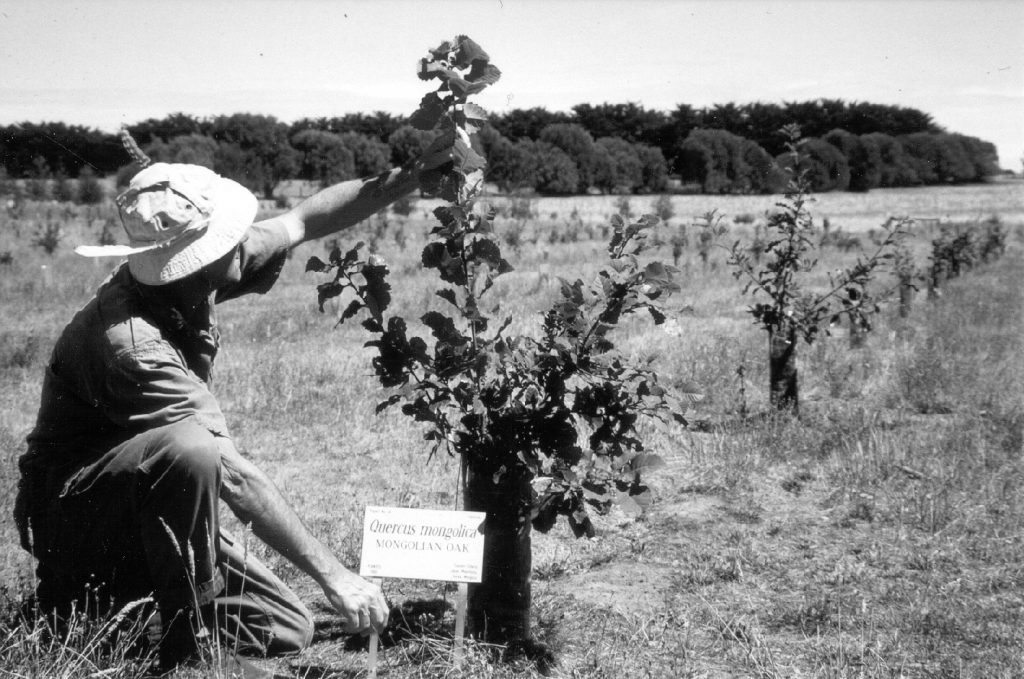
John Fenton in the early days with one of the experimental tree plantations – in this case a Mongolian Oak. Photo courtesy of Rod Bird.
I met John in the mid-1970s and, when I began to develop a farm forestry and shelter research program at the Department of Agriculture in the mid-1980s, the Fentons were happy to allow me to establish several experimental blocks of trees on Lanark. One project involved the planting of some 40 different species of trees that could produce timber, and the effect of form-pruning to produce a branch-free bole. Other blocks looked at spacing effects on growth and form. Those trees are still present, along with many others that John planted.
When John finished with all his planting about 20% of the property had been planted with trees. From my research I consider that to be economically viable and sustainable in the long-term, providing shelter benefits for livestock and man, and a living space for birds and other native animals. Of course, John hosted many groups of farmers and Landcare folk who visited the property.
John was interested primarily in trees but did not have a detailed knowledge of flora and fauna, or the time to indulge in those pursuits. However, he was a stout advocate for conservation and supported action to preserve bushland and wetlands. He was also a supporter of the local Gunditjmara people’s aspirations in the Condah-Budj Bim area and was well known to their leaders.
I remember John with fondness and am grateful for the time and energy he and Cicely gave to me in the ten years or so that I worked on tree projects at Lanark. He was a man for the time, someone who ignored the opinions of many, including stock agents, who maintained then that trees and wetlands were an impediment to farming. In doing so he helped to change some attitudes and his influence will be felt for many years to come.
John Fenton of ‘Lanark’: A Mentor and Close Friend – by Rochelle (Chel) Rudduck
John was a wonderful man with whom I had a cherished and long friendship. I first came to know him through my study of Landscape Architecture at the Royal Melbourne Institute of Technology (RMIT) in Melbourne in the late 1980s and he was pivotal to my education along with many other of my fellow students. John nurtured my understanding of, and relationship to the environment, enriching my personal values along the way, and encouraging me to sensitively and carefully consider all aspects of the landscape at every engagement.
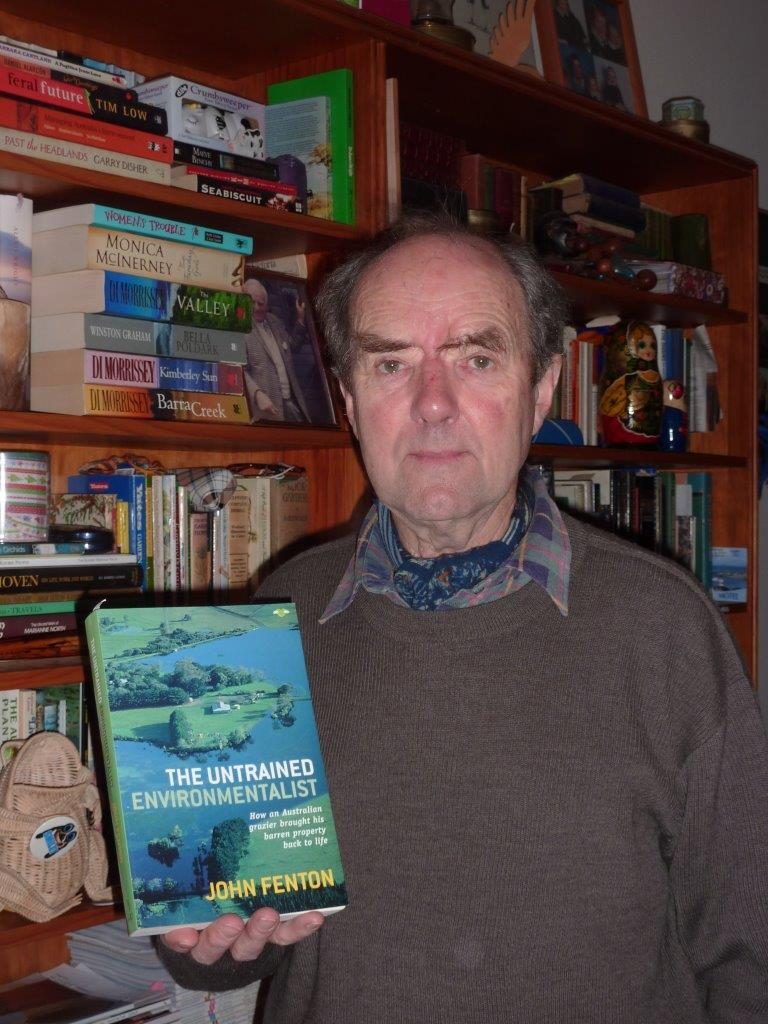
John surrounded by books, holding his own work “The Untrained Environmentalist”. Photo courtesy of Liz Fenton
The knowledge he imparted was not just about his own achievements and endeavours, but that of the extensive number of the people and practices that had influenced his own work and philosophies. These include a plethora of progressive thinkers and communities including: our First Nations people, particularly the Gunditjmara community; the noted marine biologist, conservationist and author of ‘Silent Spring’ Rachael Carson; the silviculture / forestry practices of varying cultures across the globe; the great landscape architect /maker Humphrey Repton (1752-1818); Aldo Leopold, naturalists and conservationist John Muir; and wonderful personal friends who shared his vision, (Neville Bonney, Murray Gunn, David Hay, Graeme Gunn to name a few). John could not have achieved all of this without the sacrifice and support of his wife Cicely whom he loved dearly.
John was a deeply considered, passionate spirit who cultivated that same passion and enthusiasm in others, and as such he has left a profound mark. My love of trees was truly marked by the experience of designing part of an Old World Oak Plantation at Lanark in 1993 with John and his family, which will remain a deeply special place to me. These trees are nearly 30 years years old and demonstrate some of the intrinsic values he held with regard to the integration of trees in the landscape. After completing my degree in Landscape Architecture in 1993, this Old World Oak Plantation and all the other farm forestry plantings were documented in a book we co-authored and published, ‘Lanark – Farm Forestry’ (1994). This was a great privilege.
John’s interests were broad and varied which is why he was so interesting and why we connected so well. John was the consummate raconteur who would effortlessly captivate his audience. I loved his optimism, his ability to see further, his love of music and poetry, and the piles of books in every room which demonstrated his passion for learning and reflected his open mind. John was fun to be around, because he was so positive and collaborative.
I will miss him, and will reflect on his advice often. When I need an answer to something, I will simply remember his words of encouragement and his feelings towards the landscape. “Chel”, he would say, “Never forget the romance of the landscape”.
Obituary from the Hamilton Spectator Newspaper

